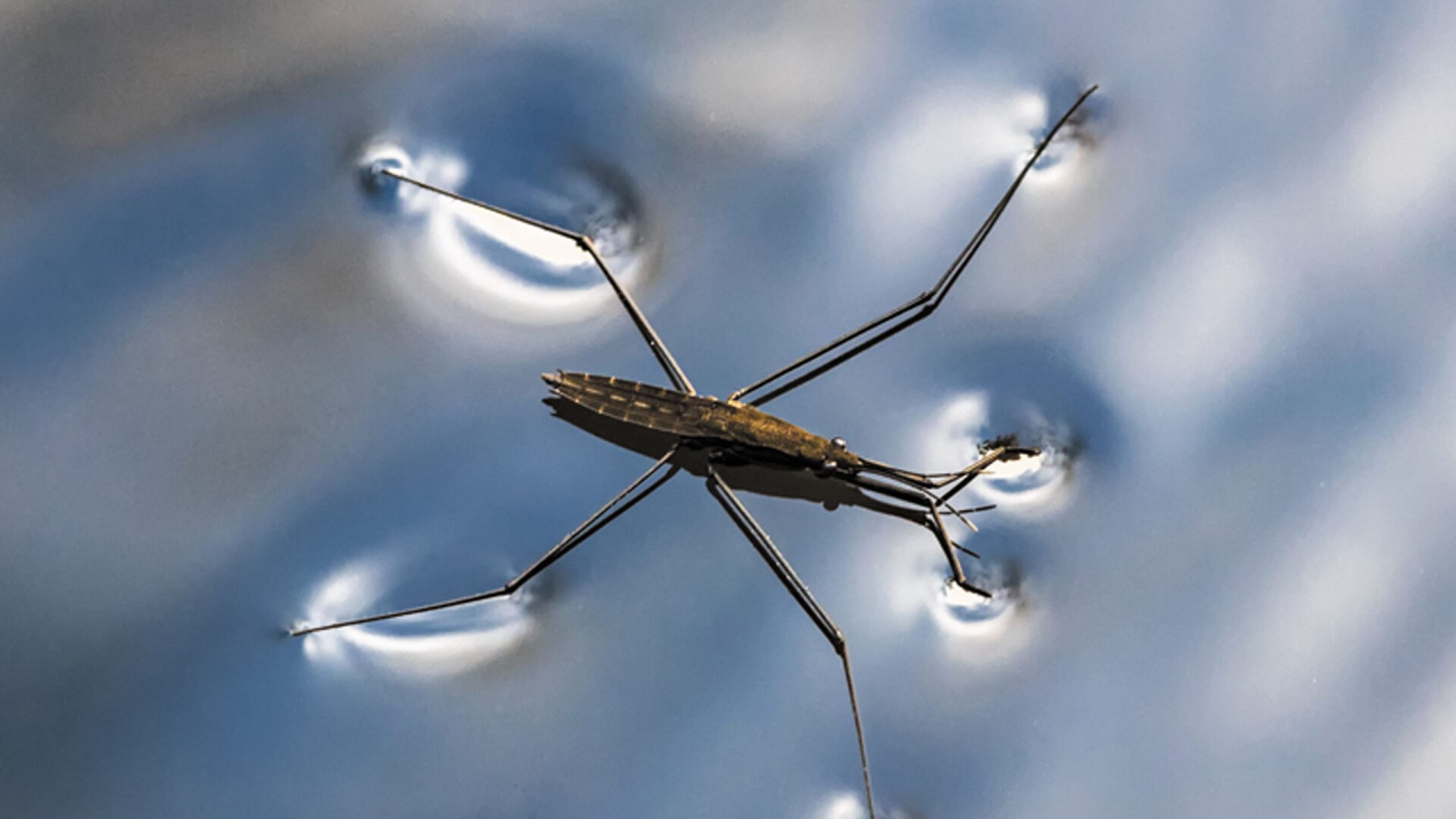Walking on Water

In This Article
-
Water striders amaze us with their unique features that enable them to “walk on water.”
-
A water strider weighs only as much as three sesame seeds combined; this is enough to bend water surfaces, but it can't break them. Thus, the surface tension supports the weight of the water strider
-
The forward movement of the water strider is based on pushing a pack of liquid backwards. By pushing the fluid backwards, they were pushing themselves forward and maintaining their momentum.
Within the narratives of saints, the act of “walking on water” stands out as a recurrent wonder. While this situation is contrary to the laws of physics and is of course met with surprise by the listeners, it is a perfectly normal way of life for a group of insects, known as the long-legged water striders (Gerris sp.), who can hover on the water surface of calm ponds and rivers as if they were on land.
These brown insects usually stand still; but they are also created with an ability to act speedily on water and make sudden movements if somehow stimulated. In the process, small waves of water are formed behind them, which spread outward. The question that comes to mind is: How do they stay on the water?
The secret lies in the fact that their body size and legs are created in such a way that they can take advantage of some of the properties given to water. Objects with a specific gravity higher than water sink, substances with specific gravity less than water (such as wood, oil) float. There is a weak force of attraction between the molecules on the surface of the water, but this is a weak force, called surface tension, and it is not strong enough to carry a person.
A water strider weighs only as much as three sesame seeds combined; this is enough to bend water surfaces, but it can't break them. Thus, the surface tension supports the weight of the water strider (Figure 1). In addition to the body size, the gap between the animal’s feet, that is, the width of the weight surface, is of great importance.
As the surface expands, the pressure made decreases. For example, when a knife is sharpened, the cutting surface is greatly reduced, so it cuts the pressed object even with even slight pressure. But if the cutting surface expands, that is, if the blade becomes dull, it is necessary to press hard to cut. Similarly, if a person tried to walk on water like a water strider, he would need feet as wide as about 10 kilometers to support his body weight, which is about 10,000,000 times the weight of a water strider.
Water striders resemble rowboats on the water. When their legs touch the surface of the water, they are covered with a silvery layer of air. Aquatic travelers have as many as 10,000 very small hairs on one millimeter of their legs. They have hairy legs that are a million times denser than the density of the hair on our head. Air is trapped between these hairs. Moreover, these microscopic hairs are covered with cavities that make them even more waterproof. Made of chitin, these bristles have an important function in increasing water repellency and increase the surface area of the leg, allowing them to stay dry. The layer of air held between the bristles allows them to glide over the water for long distances without sinking. Adult water striders can travel up to 50 times their body length per second during "paddling." This is equivalent to a human running 100 meters per second.
So, how does a water strider start its first movement? Hydrodynamic theories say that surface waves can only be generated if an animal is able to move its legs fast enough. For movement at constant speed and in a straight line, this minimum speed is 23 centimeters per second, which is low enough to be tested in a bathtub or swimming pool. The legs of the adult ones are one centimeter long, while the legs of juvenile striders are barely one millimeter long. In order to reach the required speed, baby water striders need to rotate their legs at speeds higher than 1000 cycles per second, which is 500 times faster than the speed at which we pedal on a bike, which can damage them. But since it is known that baby water striders can also initiate the first movement and continue it on the water, there must be a different mechanism.
To uncover this mechanism, scientists studied water spiders. It was noticed that spiders, as they move on the surface of the water, produce waves behind them. After this observation, the water travelers were monitored with devices capable of precise recording. The entire stroke of the paddle lasted about a hundredth of a second. (We can fit 30 paddle strokes in a single wink). It was observed that the water striders rowed with such a frequency with their middle legs, being able to move forward and upward. The water surface behind was rippling like a trampoline. But the analysis suggested that the undulating trampoline could not be the only reason pushing it forward.
In the laboratory, it was found that when the paddling of water travelers was followed using colored paints, the waves formed were only a brief image of the paddle stroke (Figure 2). The actual waves that formed were the vibrations generated by the mechanical force that came and went quickly. What really stood out were the butterfly-shaped, bipolar vortices on the back of both legs. Even baby water striders could generate vortexes with the motion of rowing. The forward movement of the water strider is based on pushing a pack of liquid backwards. By pushing the fluid backwards, they were pushing themselves forward and maintaining their momentum.
In order for a hummingbird that flaps its wings suspended in the air to maintain its level, it must constantly push the air downwards at a fairly high speed, since the air is 1000 times lighter than water. The air that is pushed down has a certain momentum, which is equal to the product of its mass multiplied by its velocity. Therefore, in order for it to remain in the air, the momentum, the speed at which it is being pushed downward, must be equal to the weight of the bird. The helicopter works in the same way: Rotating propellers propel the air, accelerating it, thereby increasing momentum, and then pressing the air downwards as compressed as possible.
In order for a fish to swim forward, it must also maintain its momentum. Moving forward, it moves in the opposite direction with the help of its fins and tail, forming a trail approximately its own size. Due to the conservation of momentum, this trail runs in the opposite direction of the fish. The trace that appears in the water usually depends on the style of the movement performed. Birds flying at low speeds create a vortex with each flap of their wings. When the basilisk lizard (Basiliscus plumbifrons) runs through the water, vortices are formed that move backwards as it presses downwards to support its weight and create thrust. Creatures such as birds, fish and lizards that move in the water have been created with the ability to make these vortices.
A water strider can create vortices the size of watermelon seeds. It uses only two of its six legs as a paddle. Since the diameter of their legs is 50 times thinner than the width of the vortex, it is thanks to their surface tension that they are able to move the liquid with their thin legs. When a water strider sits on the surface of the water, it produces pits on the surface of the water. While moving their legs, these pits are maintained without breaks on the surface of the water. Filled with air, but held together by surface tension, pits are like paddles used to catch and push away more water than the insect can do with its slender legs.
The hardest part of building a mechanical robotic water strider is that it has to be light enough to balance on the water. One of the human-like robots is the walking robot named Asimo. He is 130 cm tall and weighs about 55 kilograms. A water strider, on the other hand, weighs one-100th of the weight of a paper clip. Observing the world's largest water strider, Gigantometra gigas, scientists began to think that there was a way to build a lightweight robot. Gigantometra gigas's body is three times longer than that of a normal water strider, and its legs are almost a foot wide. Despite this, it weighs only 1 gram, that is, the weight of a paper clip.
One robotic strider has been produced in lab out of aluminum and with water-repellent (hydrophobic) qualities. Aluminum is known to be amongst the lightest, most durable, and most cost-effective metals on the market (Figure 3).
The excess weight in an aircraft's fuselage requires longer wings to create lift. Similarly, the heavier the robotic strider, the longer must be its legs to be able to support its weight on the water.
After the robotic navigator was released to the surface of the water, several waves were seen. It slowly slid forward and began to move on the surface of the water.
Inspired by God's creations, we can find living things in nature to serve as models for many more technological innovations. In the future, it may even be possible for people to walk on water. If we succeed in reading the book of the universe with this perspective, we can develop many innovations that will make human life easier by making use of animals and plants.
Reference
David L. Hu, How to Walk on Water and Climb up Walls, New Jersey: Princeton University Press, 2018.









